prehistoric art
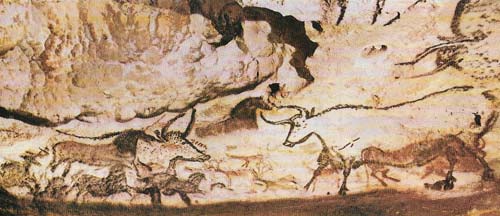
Figure 1. The famous animal paintings in the cave of Lascaux are in a style similar to the parietal art found at many other sites in the Dordogne district of France. The cave was found accidentally in 1940 by a group of boys who were out with their dog and is one of the most recent of Paleolithic cave art finds. Most of the animals in this portion of the Lascaux paintings are aurochs or European bison (Bos primigenius) which became extinct in Poland in the 17th century. They are drawn so that all four legs and both horns are visible.
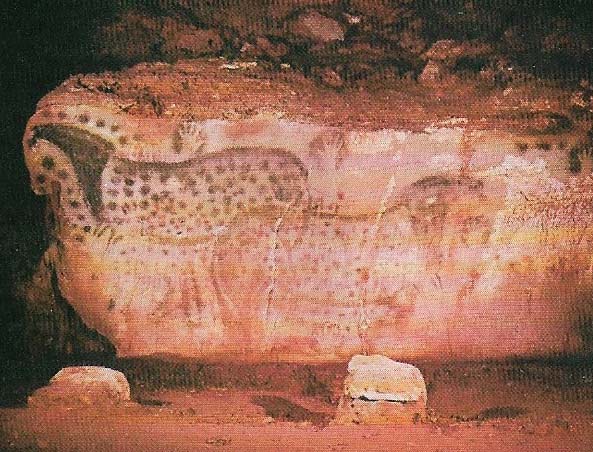
Figure 2. A wall of the cave of Pech-Merle in France shows two spotted horses with more spots surrounding them and heads and necks in solid color. The bodies are full, the limbs attenuated, a feature of much Paleolithic art. The two horses overlap and were clearly painted at different times, but whether hours or centuries apart is not known. There are also handprints made by blowing powdered pigment around a hand held on the wall.
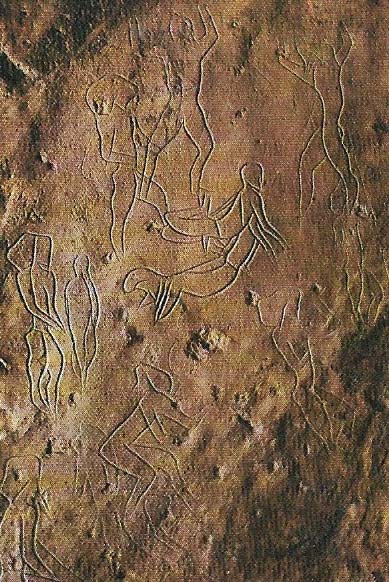
Figure 3. Engraved figures from the cave of Addaurain Sicily show humans in a variety of poses; overlapping suggests that they were not all done together. Engraving, with painting and low relief sculpture, is characteristic of the Upper Paleolithic.
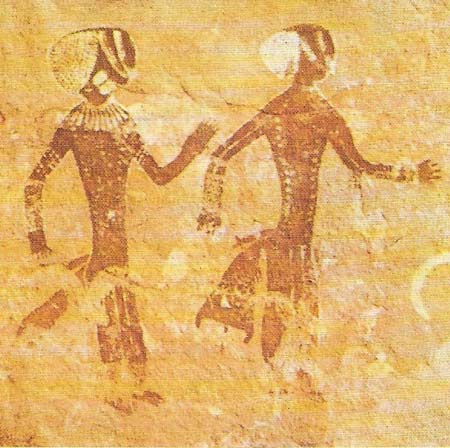
Figure 4. These striding men are painted on rock in the Tassili plateau of Algeria in the heart of the Sahara Desert. The figures themselves are shown in solid color and attention is focused on the decoration covering their limbs and bodies, probably representing body-painting with natural pigments such as is still practiced by the Nuba of Sudan. Body art may well have existed in the Paleolithic period.
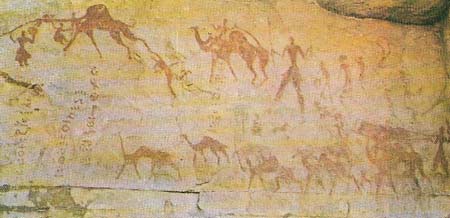
Figure 5. Tassili art persisted into the Neolithic period or later, after the camel had been domesticated, as is shown by this painted scene on the wall of a cave in the Tassili Plateau at the site of Ir Itinen. The figures in solid red depict a camel caravan and its drovers and the camels include both loaded adult animals and, at the lower left of the paintings, what appear to be younger camels.
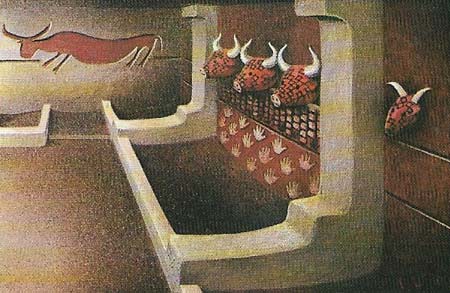
Figure 6. A shrine dating from 6000 or 7000 BC has been reconstructed at the Anatolian Neolithic site of Catal Huyuk. This site has claims to being one of the world's earliest towns, with a population of several thousand. During excavations, many animal shrines dedicated to the herds on which the economy depended were found, decorated with elaborate paintings and modeled reliefs. The shrines and most of the houses seem to have been entered through the roof.
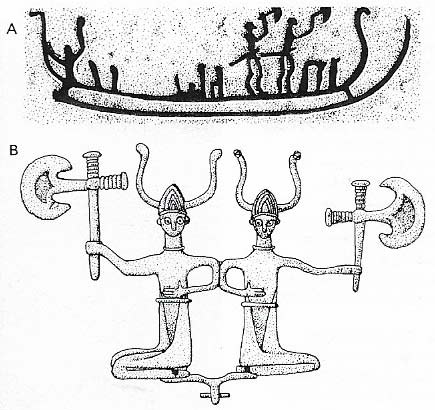
Figure 7. Scandinavian rock engravings from Bohusian and Grevenvaenge in Denmark are similar in technique to the Val Camonica carvings, and of even later date. They depict a longship (A) with three human figures or perhaps a mast and steering oar as well; and two warriors in great horned helmets brandishing battleaxes (B). The presence of a smooth rock surface presented an irresistible challenge to prehistoric graffitists through Europe and in Asia Minor.
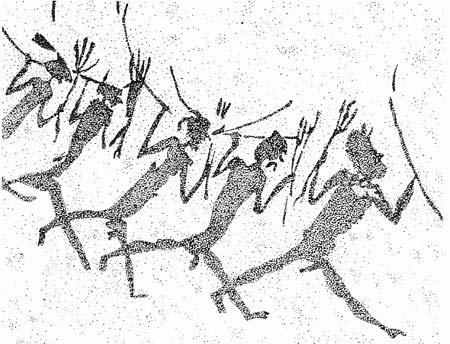
Figure 8. A group of warriors, hunters, or dancers ornament a cave called Cingle de la Mola Remigia in the Gasulla Gorge of Castella province, Spain. The naked figures of running men are painted in a monochrome gray. Each man carries a longbow and a sheaf of arrows – standard hunting (and presumably also fighting) equipment during the late glacial period when this cave was decorated.
Man's aesthetic sense seems to have developed recognizable forms of expression about 30,000 years ago, as the modern form of man, Homo sapiens sapiens, annihilated, displaced or absorbed Homo sapiens neanderthalensis. The detectable differences between these two sub-species of human being are confined to a heavier bone structure in Neanderthal man, who was otherwise as upright and large-brained as modern man. But other differences in behavior and adaptation to the environment can be guessed at from archaeological evidence; a predisposition to create art is one of them.
The "childhood of art"
With few exceptions, all of the world's earliest art is associated with the hunting economy, of Homo sapiens sapiens (Figure 8). Neanderthal man had developed ritual, perhaps religion, and the practice of ceremonial burial of his dead, but had not developed a way of expressing himself pictorially in a lasting medium. Nevertheless the earliest art, which is found in caves in southwestern France and northeastern Spain, is of some sophistication. When the art of this Upper Paleolithic period (35,000–10,000 years ago) was first discovered, in 1875, it was received with incredulity. "It is the childhood of art, but not the art of a child", said one eminent French archaeologist, and until 1900 many regarded it with suspicion. Marcelino de Sautuola (died 1888), the discoverer of the great halls of Altamira in northern Spain, was charged with having forged the paintings and it was not until other paintings were discovered in the French sites of Pair-non-Pair and La Mouthe, concealed beneath Paleolithic cultural deposits, that the skeptics were forced to recant.
The man who finally demonstrated the antiquity of Paleolithic art was Abbe Henri Breuil (1877–1961). The evidence for Paleolithic art is more or less confined to western Europe, although isolated sites such as Kapova in the Urals of Russia, Levanzo in Sicily, and Beldibi and Belbasi in Turkey exist; and a lively tradition of rock art in northern and Saharan Africa at places such as Tassili N'Ajjer (4, 5) continues down into the Neolithic period (5,000 years ago).
Paleolithic art is divided by archeologists into two major categories – parietal, consisting of paintings, engravings and sculptures on the roofs, walls and floors of caves from which they cannot be removed, and mobiliary, consisting of small portable objects. To the archeologist each type has its advantages and its frustrations; cave art, while often undated, is in its original position and context, while mobiliary art is often in well-dated archeological layers but without any context that might shed light on its use. Mobiliary art consists of single isolated figures; cave art of many adjacent figures, sometimes related to each other.
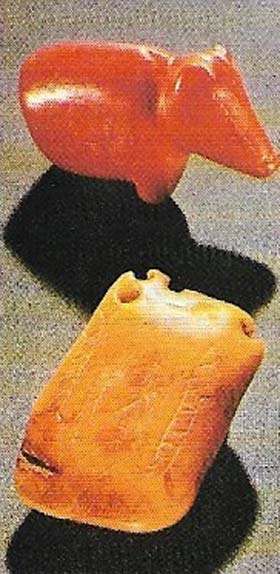 |
| These small amber carvings, including a stylized rendition of a bear, are from Siberia. Amber, a fossil resin found mainly on the shores of the Baltic Sea, was used by people from the Mesolithic period of 10,000 years ago onward. |
Distribution of cave art
Cave art is confined to a small area of France and Spain: the Dordogne valley, the high Pyrenees and the Cantabrian mountains. More than 100 caves are known, including such famous sites as Lascaux (Figure 1), Altamira, Les Trois Freres, Montespan, and Font de Gaume. In few of these, however, is the art firmly dated except by its style, and the art at Rouffignac has long been suspect.
On present evidence the earliest dated site is that of La Ferrassie, where painted blocks were found in Aurignacian culture levels dating from about 29,000 years ago. Other paintings and engravings and bas-relief sculpture were found in higher Aurignacian levels and thus the three major techniques of parietal art are all found from the earliest period onwards. Sites such as Pair-non-Pair may date from the late Aurignacian or the early Gravettian period about 25,000 years ago, while Gargas in the Pyrenees is definitely Gravettian, as also is the site at Laussel.
The brief Solutrean culture, confined to the same area as the cave art and noted for its superb flint work, has art at Le Roc de Sers. A reindeer-hunting final Paleolithic phase in western Europe, the Magdalenian, gave birth to the astonishing polychrome paintings of Altamira. It has been suggested that most of the cave art sites are of this last period. Mobiliary art is also found from the Aurignacian onwards, as an adjunct to the increasing use of bone and antler for tool-making. The best-known class of object is that of "Venus" figurines, stylized females with the buttocks and belly overemphasized and the head and legs reduced to stumps. The Willendorf Venus is more individual than most. The Venuses date mainly from the Gravettian and like it are distributed through eastern Europe, even as far as Siberia. Their gross features may be the expression of some artistic scheme of proportions, rather than simply reflecting interest in woman's fertility.
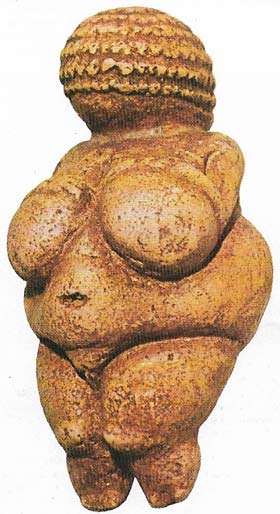 |
| The small limestone figurine known as "Venus of Willendorf" from a Gravettian site in Austria is 20,000 to 25,000 years old. The large breasts, belly, and buttocks are typical of this form of mobiliary art. |
Art or magic?
A number of explanations have been advanced for cave art, the simplest of which is that it is "art for art's sake". The theory of Breuil, accepted for many years, was that it was connected with obtaining magical power over the animal hunted by drawing it and also with the totemic association of man and animal species. More recent suggestions that the paintings may be sexually symbolic have not found wide acceptance. Some scholars are using comparisons with the more recent rock art of the Kalahari and the Australian Aborigines to cast further light on the mind of prehistoric man.
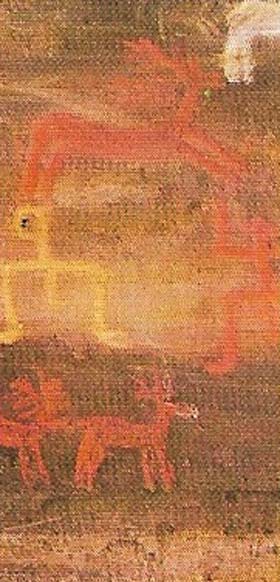 |
| Rock engravings found in the Val Camonica, northern Italy, date from the Bronze Age. Some of these open-air carvings, which are pecked into smooth glaciated rock surfaces, show elaborate scenes, including chieftains in procession. This example (filled with colored pigment to assist photographic visibility) depicts three reindeer and two schematic human figures. The significance of these scenes is unknown and the variety suggests many motives. |
